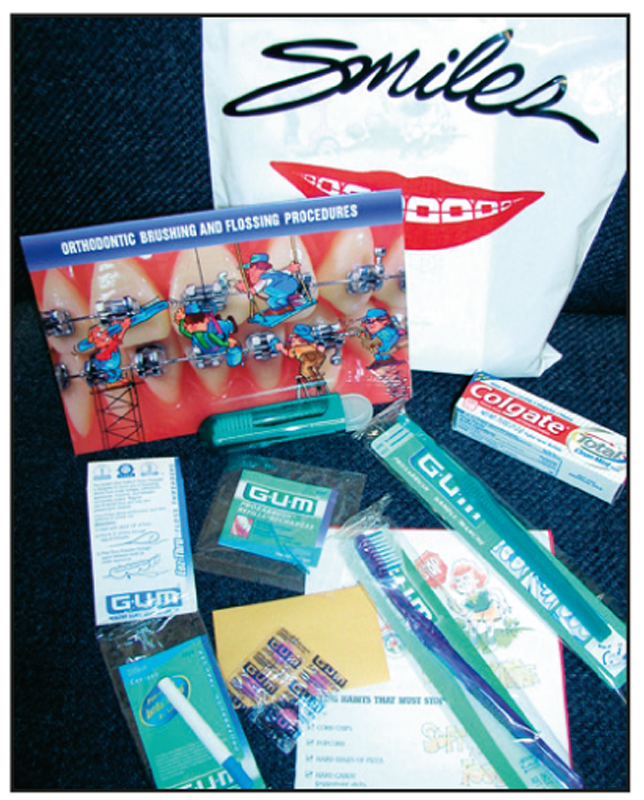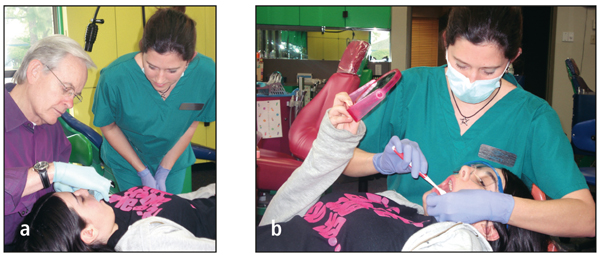
Create Compliance
Although every patient is unique in some ways, every patient is also the same in many ways. In most cases, the general treatment plan, as outlined in these principles, is to treat the maxillary arch first using a specific sequence of archwires. If the patient requires orthopedic correction, such treatment is initiated in the maxillary arch with a rapid palatal expander and/or facebow or face mask.
About 4 to 6 months later, treatment is initiated in the mandibular arch. A specific series of archwires is used to position the mandibular teeth. After the finishing archwires are in place, appropriate elastics are used to coordinate the arches and finalize the occlusion. Retainers are then placed.
Following these basic step-by-step procedures in a routine system, the orthodontist can stay in complete control of each patient. Because the treatment needs at the next appointment can be anticipated, future scheduling is simplified, and progress can be easily monitored so that the treatment is completed on schedule. The bottom line is a well-treated case, finished in a timely fashion, resulting in happy parents, patient, and orthodontist—if the patient is compliant.
What makes orthodontics such a unique profession is the necessity to rely on the patient to follow the orthodontist’s instructions. The reality is that moving the teeth by archwires, functional appliances, and elastics makes the teeth hurt. Somehow the orthodontist must communicate with the patient and parents that the discomfort experienced after almost every appointment will be worth it in the long term. This can be called delayed gratification.
This principle suggests techniques for improving the compliance exhibited by patients. The effectiveness of these techniques is dependent on the positive attitude and efforts of the orthodontist.
Adopting and Adapting Motivational Techniques
There is no doubt that successful orthodontic results can be enhanced by the patient’s positive compliance; the question, then, becomes how to achieve this compliance. Various ways of achieving patient cooperation are possible. However, the methods and techniques used will vary with each patient and orthodontist.
While the mechanics of treatment described in this book can be used for any patient in the world, the techniques of motivating patients can vary greatly within any given community or country. The suggestions expressed in this principle are based on experience with patients treated in my office in Arlington, Texas, over a period of 40 years. Even within the same practice, the attitudes of the patients have changed over the years. Methods of motivation that will work every time on one patient may never work on another. The way a 12-year-old patient in Texas thinks may be completely different from the way a child who lives in Germany or South America thinks. Every patient, however, deserves the opportunity to accept personal responsibility and to succeed in the endeavor.
Some readers may believe that the thoughts and suggestions mentioned here are silly and useless. For those readers, that will be true. However, for those who believe in these concepts and apply them through their own thoughts, style, and technique, these methods will work. The reader should study this chapter and see how the principles described on the following pages can fit into his or her own personality and attitude.
The good news is that kids are kids throughout the world. By taking a few extra minutes to educate and motivate patients, orthodontists can increase the chances for successful orthodontic treatment. Not only will this special time be motivational to patients during their treatment, but also the thoughts and ideas learned can be internalized and continue to have a positive influence on their entire lives.
Degrees of compliance
Orthodontists often seem focused on how to treat the “noncompliant” patient. Appliances such as the Herbst appliance, the pendulum appliance, and magnets may be able to correct Class II malocclusion regardless of the patient’s compliance. Although these appliances or other orthopedic approaches are effective in certain cases, removing all responsibility from the patient could compromise the treatment plan.
The reality is that there is no such thing as noncompliant treatment. Every patient must brush properly, avoid certain foods, wear elastics, and come to appointments. Rather, the differences exhibited are in the degree of compliance. Unfortunately, some patients fail to take responsibility for their actions. Although words such as effort, responsibility, and discipline may not be fashionable, they should be included in the basic patient education program in every orthodontic practice. Doctors are given the opportunity to have a positive influence on their patients’ attitudes, in addition to straightening their teeth, as patients are encouraged to accept personal responsibility and experience the success of their efforts.
One of the great joys in life for me has been seeing patients change in both their physical appearance and their mental attitudes. Letters from patients and parents, and even comments from patients many years later, demonstrate that these motivational efforts did not fall on deaf ears.
Goals of orthodontic treatment
The generally accepted goal of orthodontic treatment is a high-quality finished result. However, the reality is that different practitioners have different objectives and different perceptions of quality in achieving this goal. For example, in the treatment of Class II skeletal patterns, the nature of a balanced profile, the proper position of the mandibular incisors, and the desirable amount of buccal expansion—all of which affect long-term stability—are controversial issues among orthodontists of diverse opinions.
Regardless of the differences in treatment approaches, motivating patients to follow the instructions of the practitioner will provide better results. The reality is that every patient, regardless of the appliances used, must be compliant to a degree. The basics, such as maintaining oral hygiene, eating proper foods, keeping appointments, and wearing elastics, must be followed by every patient if there is to be any chance for successful results.
Creating Compliance
It is possible to improve a patient’s willingness to follow instructions. Just as orthodontics itself remains so much an art, the psychological treatment of the patient is every bit as important an art. This technique of compliance can be taught just as can the mechanics of orthodontics. However, certain factors must be present to motivate the patient to follow instructions.
Confidence in technique
The first requirement for creating a compliant patient is that the clinician believe in his or her technique, and the staff must have confidence in the anticipated results when the patient follows instructions. Kenneth Cooper1 has said, “Your beliefs are the most powerful motivational tools you have—if you can just learn how to use them.” Keeping treatment simple and executing a step-by-step plan will make education and monitoring easier if the orthodontist knows these efforts will produce the anticipated results. Consistent, high-quality results can be produced when the principles discussed in this book are followed (Fig 20-1).
The definition of quality is the conformance to requirements. The requirements for orthodontics are well known. If orthodontists just do what they know they should do, they will produce high-quality results.
When I discuss with patients the benefits of wearing a facebow, they can feel my belief in these techniques. Orthodontists must communicate, each in his or her own way, that they know the treatment will work if the patient will follow instructions.
Patient education
The second requirement for ensuring compliance is that patient and parents understand exactly what to do and why it is important. Parents must be included. The need for parental support is critical. They need to know the costs and benefits of treatment in time, money, and effort. This education takes time—staff time and orthodontist time. Although efficiency experts may talk about “saving” time, people can actually only “spend” time. The question is how to spend that time most effectively. If less time is spent worrying about orthodontic mechanics, more time can be spent on patient education (Figs 20-2 and 20-3). Thorough patient education at the beginning of treatment can eliminate many problems down the road; that is, “inform before you perform.”
Fig 20-2 This patient-education booklet is given to all patients at their first appointment. It introduces the doctor, discusses treatment planning, early treatment, full treatment, braces, additional appliances, Invisalign, and lingual braces. It also includes foods to avoid during treatment, proper care and brushing techniques for braces, and retention. This booklet is available through OREC.
Fig 20-3 Patient education for adults is completely different, and therefore a completely different booklet is needed. Included are dramatic results of surgery patients and important differences in adult treatment. Diagnosis and treatment planning are discussed, along with
treatment options. A future volume in this series will devote a full chapter to adult orthodontics.
A kit given to the patient after the maxillary brackets are placed includes a regular toothbrush, a travel toothbrush, toothpaste, fluoride gel, interproximal brush, travel interproximal brush, floss, floss threader, Superfloss (Oral-B), disclosing tablets, and wax (Fig 20-4).
The assistant demonstrates the proper use of the toothbrushes, floss, and interproximal brushes. The patient then repeats these procedures in front of the assistant and parent.
Educating the patient means more than a monotone recitation of a set of instructions. Orthodontists and their staff should try hard to communicate and enjoy making new friends with the patients and parents. Contemporary orthodontic techniques allow many treatment procedures to be taught and delegated to staff members, freeing time for the practitioner to personally educate patients and parents. However, it is critical that staff members understand what is expected of them when they are assigned to educate patients. Time must be spent educating the staff before the staff personnel can help educate the patient. Patients must understand exactly what to do and why it is important. Time must be taken to educate them (Fig 20-5).
Patient motivation
The third requirement for creating a compliant patient is the ability of the orthodontist and staff to motivate the patient. First, the members of the practice must accept the premise that people can change. In the words of William James (sometimes called the “father of American psychology”), “The most important discovery of the 20th century is that the attitudes of an individual can change.”2
The lesson to learn from a study of motivational techniques3 is that the one truly successful method/>
Stay updated, free dental videos. Join our Telegram channel

VIDEdental - Online dental courses







